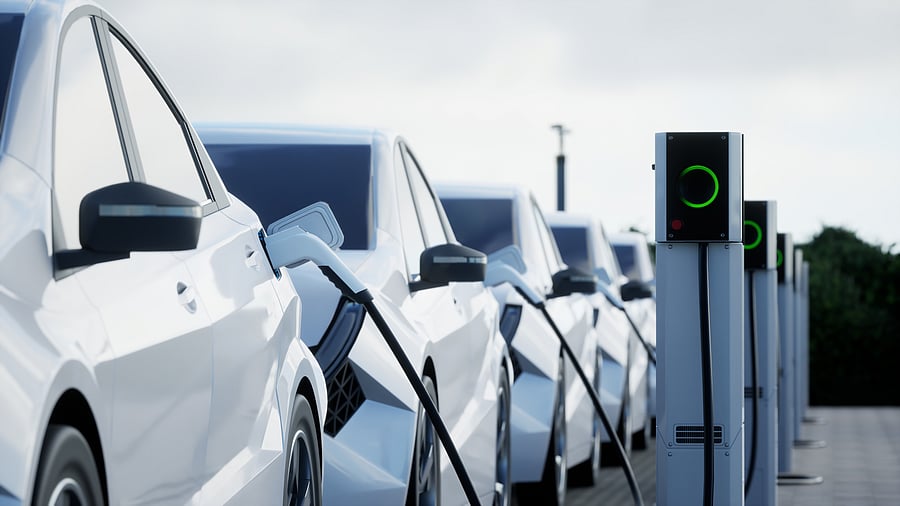
Representative image for EV.
credit: iStock
India’s electric mobility transition has gathered pace in recent years, driven by a mix of policy incentives, private investment, and growing consumer confidence. Yet, as encouraging as the growth has been, one structural gap remains stark: nearly two-thirds of an electric vehicle’s components—from batteries and motors to power electronics—are still imported.
This dependence on imports weakens supply chain resilience and limits how much value India captures from its own domestic demand. Closing that gap could unlock an opportunity worth about Rs 1 lakh crore for Indian manufacturers and MSMEs. To do so, India must rethink how technology development, regulation, and industry collaboration intersect.
India’s EV future must be developed, not assembled. India has already shown that it can scale fast; now it must prove that it can design deep. Manufacturing growth cannot depend indefinitely on imported technology. The next phase of EV expansion will be driven not by capacity, but by the ability to design, test, and build advanced systems indigenously.
Creating local innovation pipelines -- where research institutions, industrial R&D, and policy frameworks converge -- is key to achieving this. India’s ecosystem is rich in scientific expertise, but its translation into scalable products remains sporadic. What is missing is not knowledge but the connective tissue that allows technology to travel from lab to factory floor.
Regulatory readiness is no longer the bottleneck. India’s regulatory ecosystem is, in many ways, ready for this leap. As Manoj Desai, deputy director at the Automotive Research Association of India (ARAI), notes, India’s EV standards are already globally harmonised and technology-agnostic. That alignment ensures Indian EV components can meet international safety and performance benchmarks.
Equally important are the sandbox environments and satellite centres that ARAI and other agencies have introduced, allowing startups and MSMEs to conduct early validation at lower cost. These developments have quietly reduced one of the biggest barriers to localisation: the time and expense of compliance. Faster validation leads to faster commercialisation, a simple but crucial advantage.
For too long, India’s auto sector has focused on adaptation rather than invention, refining global designs for local conditions rather than leading with its own. As Prof. Anindya Deb of IISc has observed, true competitiveness will come only when Indian manufacturers invest more deeply in research & development, materials science, and design innovation.
That shift in mindset is critical. India’s unique climatic, logistical, and cost realities demand technologies born from its own context. Once domestic R&D begins to reflect those conditions, designing its own traction motors, indigenous battery chemistry design, and its own power electronics, Indian products will stop chasing the global curve and start shaping it.
If there is one area that will define India’s EV competitiveness in the next decade, it is power electronics—the circuitry that controls, converts, and manages power across every EV subsystem. As Akshaye Barbuddhe, Director of Impactware Technologies, has noted, India still depends on imports for high-value components like switchgear and DC charging systems.
Localising this layer could have outsized benefits. The efficiency, reliability, and cost of an EV are determined by how well its power electronics are designed and integrated. Building domestic capability here will not only strengthen supply chains but also create space for MSMEs and regional suppliers to enter high-value segments of the market.
Add to this the rise of smart charging networks and digital energy management, and India’s MSMEs stand at the crossroads of innovation and opportunity, one where domestic capability can meet global demand.
To build an indigenous EV backbone, India must bridge three interlocking gaps:
Mindset. Move from being risk-averse to roads less travelled.
Capital. Build patient, long-term funding pipelines for product development and research.
Skills. Train engineers not just to assemble, but to design, test, and innovate.
These are not short-term fixes. They require a deliberate national effort to encourage market-driven and design-led innovation. Between now and 2047, as India aims for a Viksit Bharat, electric mobility can serve as a proving ground for how academia, industry, and policy can truly collaborate. India’s EV future will not be decided by how many vehicles it produces, but by what kind of technologies are created. The countries that design, test, and own the core technologies of the EV era will shape the global mobility landscape.
(The writer is the director of Product Acceleration, Foundation for Science Innovation and Development–IISc)
Disclaimer: The views expressed above are the author's own. They do not necessarily reflect the views of DH.